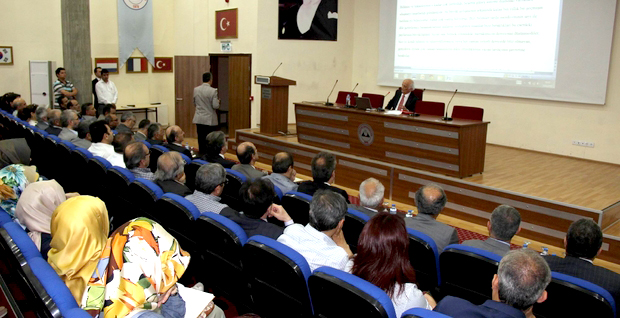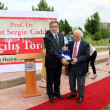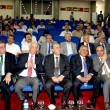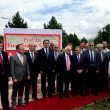TÜBA Honour Member Prof. Dr. Fuat Sezgin has given a conference titled ‘Previously Undiscovered Incredible Contribution of Muslims to Geography History’
TÜBA Honour Member Prof. Dr. Fuat Sezgin attended the opening of the avenue in the Erciyes University Campus which carries his own name on June 15, 2015. Prof. Dr. Sezgin gave a conference on ‘Previously Undiscovered Incredible Muslim Contribution to Geography History’ after the opening.
TÜBA Council Member and ERU Rector Prof. Dr. Fahrettin Keleştimur, who gave a speech at the opening, said that “Prof. Dr. Fuat Sezgin is the most important name today in the field of Islamic Science History. His contributions to the science history of our ancient civilization will not be forgotten. Without him most pieces and inventions may never have been known. We will make the name Fuat Sezgin live forever by giving his name to this street. Our university will be honored”. Afterwards Rector Keleştimur presented Prof. Dr. Fuat Sezgin a plaque. After the speeches, Prof. Dr. Fuat Sezgin Street was opened by the protocol members.
Prof. Dr. Fuat Sezgin, who started his conference by stating that he started writing the 10th volume of his book, Islamic Sciences History, on geography field in 1984 continued so:
“I started writing the 10th volume of my book Islamic Sciences History on geography in 1984. I had Kraçkovski’s and André Miquel’s perfect books as resources, other orientalists’ hundreds of books and articles published by our Institute and the microfilms of many handwritten pieces, provided by libraries around the world. With these I believe that my Science History books geography section can be completed. Out of sheer luck, in 1984 when I first began my work, I found a 27 volume Arabic encyclopedia from the 14th century in Topkapi Palace which had a world map from the first quarter of the 9th century, made by many geographers and astronomers under the employment of the Abbasid Caliph al-Ma’mün. This map was known to exist but had been lost. This map dates back to the 14th century, and is one of the many copies made of the many copies, and differs from the original.
The coordinate measuring tool, presented by al-Harezmî, used when making the Al-Ma’mün map was also found. This tool allows us to replicate the al-Ma’mün map flawlessly.
I would like to emphasize that Muslim geographers did not prepare this map from scratch. World maps by the Babylonians and Egyptians have also reached us. Muslims knew of Batlamyus’ Geographike Hyphegesis (Introduction to Geography) and Marinos’ world map (who lived fifty years after Batlamyus). I believe that Batlamyus, like many geography historians made no maps. In his book, it is estimated that he provided a way to lessen Marinos’ exaggerated values and made new latitude and longitude values for a new map. Among the values he gave are many astronomically found latitudes and only one longitude: between Kartago-Arbela (Tunus-Erbil). This had an error of 11°. Towards the end of the 13th century a Greek priest named Maximos Planudes made a world map based on Batlamyus’ book. I personally believe that he was, to some extent, inspired by the al-Ma’mün map. Not without reason, of course.”
I would like to point out these important points about the Al-Ma’mün map:
1. This map is spherical, it has sloping meridians that get narrower as you go further north or south.
2. The length of the Mediterranean goes from Batlamyus’ 63° to 52°.
3. Oceans surround the lands, the Indian and Atlas oceans are no longer lakes like in Batlamyus’ map.
Measuring the latitude and longitude of the inhabited world has spread like wildfire in the Islamic world after the al- Ma’mün map. Al-Ma’mün geographers placed the zero meridians on the Canary Islands like Batlamyus. This work of measuring the planet’s coordinates advanced so much that Muslims had lowered the Mediterranean’s length to 44-45 degrees by the end of the 10th century. This correction, made in such short time, took the longitude 17° 30’ west of the Canary Islands and based Toledo’s longitude on 28° 30’.”
One of the results of this, according to Prof. Sezgin, was that European sailors acquired the perfect Islamic world maps of the Mediterranean. “Modern geography historians who do not know of Muslims’ work in cartography are quick to assume it is a success of European cartographers. There is one other truth that in the 9th and 10th centuries the Mediterranean was effectively a lake belonging to the Muslims. This fact was proven by Polish T. Levicki with Arabic resources and by E. Eickhoff with Latin resources”.
Prof. Dr. Fuat Sezgin ended his speech with the following statements: “I cannot state the role Muslims had in human geography in this short speech. I have tried to explain all that I know in the 14th and 15th volumes of my book. For now I will briefly discuss three Ottoman geographers. Pîrî Re’is, Abü Bakr b. Bahram ad-Dimaşqi, Evliya Çelebi. Pîrî Re’is was the best author of Mediterranean geography in the 15th and first half of the 16th century. The Mediterranean was, in the Islamic world, very well processed before Pîrî Re’is, the maps of the coasts and islands were made perfect before the 13th century. The parts that needed improving were improved by the Ottoman, including Pîrî Re’is. One of Pîrî Re’is’ contributions was on deep sea archeology. The Atlantic map which bears his name was the translation of an Arabic map which had fallen into Spanish hands. Abü Bakr b. Bahram was, according to remaining pieces, one of the best to reflect the human geography of Anatolia, Iran and the Arabian Peninsula, along with Evliya Çelebi. Evliya Çelebi, during a 40 year journey, collected his own observations as well as resources from libraries in order to author a magnificent anthropogeography about Asia, Europe and Africa in ten volumes. The German geographer Hanno Beck said in 1954 about Oscar Peschel’s 1877 geography history piece: “Peschel wrote the history of a science that did not yet exist, like so many before and after him. Sadly Beck was, like prior and precedent colleagues unaware of the magnificent success of the Islamic world”.
Who is Prof. Dr. Fuat Sezgin?
He was born in Bitlis in October 24, 1924. He studied at Istanbul University Faculty of Literature Orientalism Institute Islamic Sciences and Orientalism Department alongside German orientalist Hellmut Ritter, who was a leading figure of orientalism. On Ritter’s recommendation he raised his daily scientific study time to 18 hours. Prof. Dr. Fuat Sezgin, whose name we gave to this street in our university, dedicated his life to studying Islamic Science History, and is one of the leading authorities of this science. Of all of the resources he used, none were translated. Instead, he learned the language they were written in and read from the original manuscripts. By doing this he has learned nearly 30 foreign languages. In 1961 Fuat Sezgin went to Germany, and gave classes at Frankfurt University first as an adjunct associate professor. In 1965 he became a professor at Frankfurt University. For almost thirty years, he carried on with his work in the Johann Wolfgang Goethe University’s Arab-Islam Sciences History Research Institute in Frankfurt, of which he was the founder and director. In this institute he published around 1400 books on Islamic Science History. In his library consisting of 10 thousand hand written books, he learned binding and bound the books himself. Prof. Dr. Sezgin is also the founder of the Goethe University Arab-Islam Science History Research Institute Museum. In this museum there are around 800 pieces related to Islam Science history. In this place in 1965 habilitation work has been made. His Arab-Islam literature history piece (GeschichtedesarabischenSchrifttums), which he started working on when he was still in Istanbul, covers 7th/14th century Arab-Islam literature which he continued to work on in Germany, and finished as an unparalleled 13 volume masterpiece, the first volume of which was released in 1967 and the last in 2000. Sezgin, who covered every main and side branch of science in GeschichtedesArabischenSchrifttums from Islam’s first period to religious and historical literature to geography and cartography, had replicas made of the tools he prepared for the Arab-Islam Science Institute, and played an important part in the opening of the Istanbul Islam, Science and Technology Museum which is tied to the Ministry of Culture and Tourism on May 25, 2008.
Prof. Sezgin is the first person to get the Saudi Arabian Kin Faysal Foundation Islamic Sciences Award in 1978. He also has an outstanding service award from the Germany Federal Republic. He has been found worthy of many awards, including the Iran Islamic Sciences Book Award. Prof. Dr. Sezgin still has pieces in TÜBA, TÜBİTAK, the Moroccan Science Academy and the Arabic Language Academy situated in Cairo, Damascus and Baghdad. Prof. Dr. Fuat Sezgin, who is our esteemed guest at our University, is married to colleague Dr. Ursula Sezgin and they reside in a place near Frankfurt.




